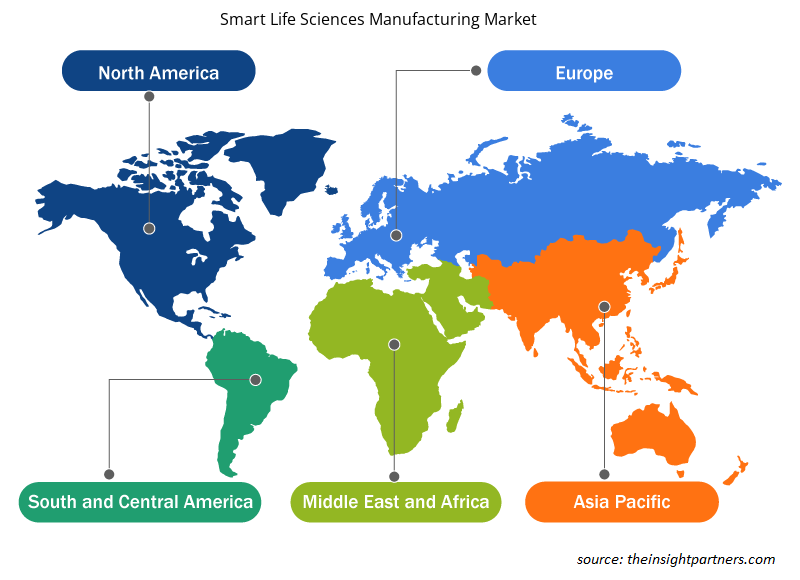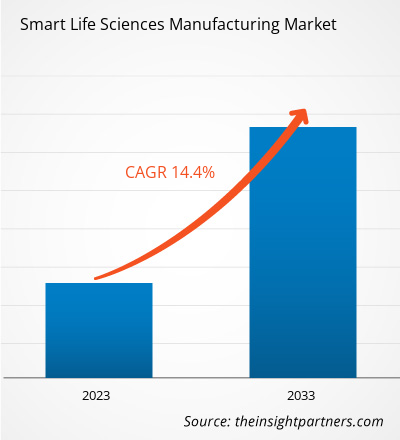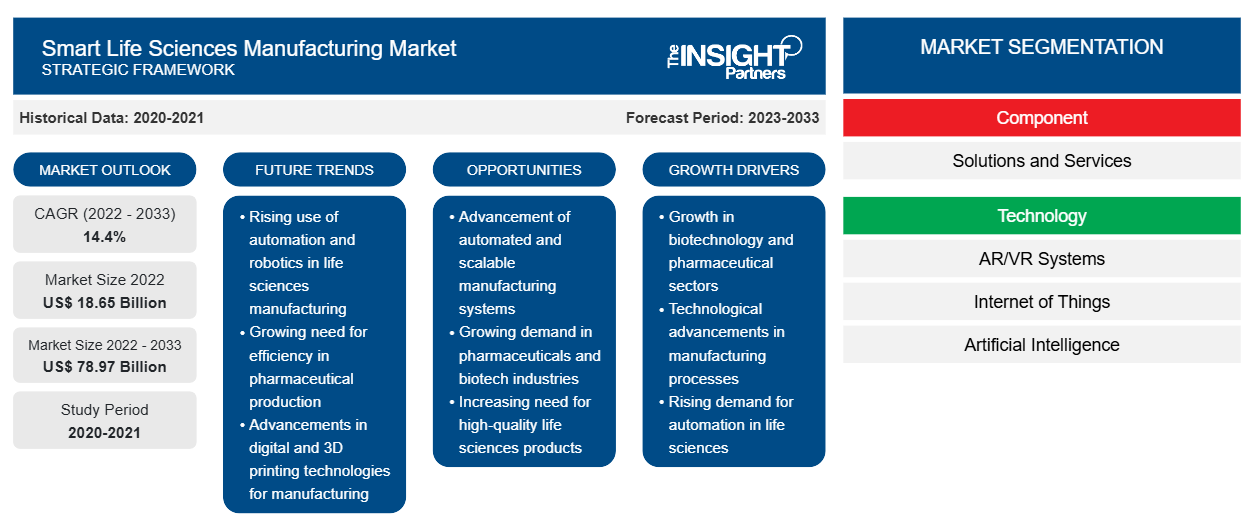Se proyecta que el mercado de fabricación de ciencias biológicas inteligentes alcance los 78.974,61 millones de dólares en 2033, desde los 18.649,50 millones de dólares en 2022; se espera que registre una CAGR del 14,4 % durante 2023-2033.
El proceso de fabricación de las ciencias de la vida ha cambiado significativamente en los últimos diez años. La fabricación de las ciencias de la vida es un proceso complejo. Un concepto de fábrica inteligente que interconecta la maquinaria y el sistema en el sitio de producción puede simplificar el proceso de fabricación. El sistema también está conectado con el cliente, el socio y el sitio de producción. Después de la pandemia de COVID-19, muchos fabricantes de productos farmacéuticos y dispositivos médicos comenzaron a adoptar la tecnología farmacéutica 4.0, especialmente debido al aumento de las regulaciones y las preocupaciones por la inspección. La fabricación inteligente de las ciencias de la vida, a menudo conocida como Pharma 4.0, tiene como objetivo proporcionar una guía práctica, integrar las mejores prácticas regulatorias y acelerar las transformaciones de Pharma 4.0. El objetivo principal es permitir que las organizaciones que participan en el ciclo de vida del producto farmacéutico controlen todo el potencial de la digitalización y brinden innovaciones terapéuticas más rápidas y procesos de producción mejorados para el beneficio de los usuarios finales. Estos cambios traerán enormes oportunidades a los fabricantes de ciencias de la vida en los próximos años. Las modernas herramientas de análisis de datos han permitido a los investigadores de biotecnología crear modelos de análisis predictivos y comprender las formas más efectivas de lograr sus metas y objetivos. Big data, IA, realidad virtual, visualización de datos y seguridad de datos se encuentran entre las tecnologías comunes que se utilizan en los laboratorios de biotecnología. Se espera que estos factores impulsen fuertemente el tamaño del mercado de fabricación de ciencias biológicas inteligentes en los próximos años.
Mercado de fabricación de ciencias biológicas inteligentes -
Personalice este informe según sus necesidades
Obtendrá personalización en cualquier informe, sin cargo, incluidas partes de este informe o análisis a nivel de país, paquete de datos de Excel, así como también grandes ofertas y descuentos para empresas emergentes y universidades.
-
Obtenga las principales tendencias clave del mercado de este informe.Esta muestra GRATUITA incluirá análisis de datos, desde tendencias del mercado hasta estimaciones y pronósticos.
Perspectivas de mercado: mercado de fabricación inteligente de ciencias biológicas
El segmento farmacéutico es un contribuyente clave al sector industrial global. Además, la demanda y las ventas de medicamentos aumentan cada día. Por ello, las empresas de fabricación farmacéutica invierten enormes cantidades de recursos económicos en I+D para llevar innovaciones al mercado. Las actualizaciones tecnológicas son la clave para abordar los futuros problemas de fabricación. Con esto, el mercado Pharma 4.0 está ganando una gran atención en todo el mundo. En junio de 2022, GSK, una gran farmacéutica británica, inauguró su nueva planta de fabricación inteligente aséptica en Barnard Castle, Inglaterra. Esta planta totalmente automatizada aprovecha la digitalización para agilizar el proceso de fabricación. Esto, a su vez, permitiría a GSK acelerar el lanzamiento de nuevos medicamentos y reducir el desperdicio. En diciembre de 2020, Bayer AG anunció el lanzamiento de una plataforma de terapia celular y génica dentro de su división farmacéutica. Esta plataforma combinará múltiples funciones de columna vertebral para brindar soporte en toda la cadena de valor de la investigación y el desarrollo de terapias celulares y genéticas . En noviembre de 2020, el Reino Unido comenzó a construir una "fábrica del futuro" para renovar la producción de fármacos de moléculas pequeñas. Se espera que los fabricantes de medicamentos, las instituciones académicas, los proveedores de atención médica y los reguladores se reúnan en las instalaciones para probar y mejorar nuevas tecnologías, incluida la fabricación continua, digital y autónoma. Por lo tanto, se espera que la creciente adopción de la transformación digital impulse el tamaño del mercado de fabricación inteligente de ciencias biológicas.
Información basada en componentes
El mercado de fabricación inteligente de ciencias biológicas, por componente, se bifurca en soluciones y servicios. Se espera que el segmento de soluciones tenga una mayor participación en el mercado de fabricación inteligente de ciencias biológicas durante el período de pronóstico, a pesar de registrar tasas de crecimiento más lentas que el segmento de servicios. La industria farmacéutica está adoptando rápidamente la transformación digital a medida que la digitalización aporta flexibilidad y eficiencia a los procesos. Con la creciente complejidad de los sistemas y procesos de producción, establecer la interconectividad e implementar soluciones robustas de fábrica inteligente en línea con las buenas prácticas de fabricación (GMP) se han convertido en una prioridad estratégica para las empresas de ciencias biológicas. Además, la Industria 4.0 ha simplificado el proceso de acceso a los datos de las operaciones, además de permitir que las empresas cumplan con los indicadores clave de rendimiento (KPI) específicos. Las soluciones de fabricación inteligente ayudan en la gestión de la calidad al monitorear la temperatura y la humedad del inventario, monitorear la visibilidad del proceso de extremo a extremo, mejorar la consistencia del producto e identificar problemas específicos relacionados con la fabricación por lotes. La industria de las ciencias biológicas se dedica al desarrollo de tratamientos novedosos, efectivos, de calidad y precisos. Los pioneros de la industria están explorando nuevas áreas y enfoques terapéuticos aprovechando los últimos avances tecnológicos para obtener una ventaja competitiva. Estos factores impulsan el crecimiento del mercado de fabricación de ciencias biológicas inteligentes para el segmento de soluciones.
El mercado de fabricación de ciencias biológicas inteligentes está segmentado en función de los componentes, la tecnología y la aplicación. Según los componentes, el mercado se bifurca en soluciones y servicios. Por tecnología, el mercado de fabricación de ciencias biológicas inteligentes se segmenta en sistemas de realidad aumentada/realidad virtual (RA/RV), Internet de las cosas (IdC) , inteligencia artificial (IA), ciberseguridad, big data y otros. El segmento de IoT comandó la mayor participación de mercado de fabricación de ciencias biológicas inteligentes en 2022. Según la aplicación, el mercado de fabricación de ciencias biológicas inteligentes se segmenta en productos farmacéuticos, biofarmacéuticos y dispositivos médicos. Según la geografía, el mercado de fabricación de ciencias biológicas inteligentes se segmenta principalmente en América del Norte, Europa, Asia Pacífico (APAC), Oriente Medio y África (MEA) y América del Sur (SAM). ABB Ltd, Bosch Rexroth AG, Emerson Electric Co, Fortinet Inc, General Electric Co, Honeywell International Inc, IBM Corporation, Rockwell Automation, Siemens AG y Sophos Group plc se encuentran entre los actores clave del mercado de fabricación de ciencias biológicas inteligentes.
Perspectivas regionales del mercado de fabricación de ciencias biológicas inteligentes
Los analistas de Insight Partners explicaron en detalle las tendencias y los factores regionales que influyen en el mercado de fabricación de ciencias biológicas inteligentes durante el período de pronóstico. Esta sección también analiza los segmentos y la geografía del mercado de fabricación de ciencias biológicas inteligentes en América del Norte, Europa, Asia Pacífico, Oriente Medio y África, y América del Sur y Central.

- Obtenga datos regionales específicos para el mercado de fabricación de ciencias biológicas inteligentes
Alcance del informe del mercado de fabricación de ciencias biológicas inteligentes
| Atributo del informe | Detalles |
|---|---|
| Tamaño del mercado en 2022 | US$ 18,65 mil millones |
| Tamaño del mercado en 2033 | US$ 78,97 mil millones |
| CAGR global (2022-2033) | 14,4% |
| Datos históricos | 2020-2021 |
| Período de pronóstico | 2023-2033 |
| Segmentos cubiertos |
Por componente
|
| Regiones y países cubiertos |
América del norte
|
| Líderes del mercado y perfiles de empresas clave |
|
Densidad de actores del mercado de fabricación de ciencias biológicas inteligentes: comprensión de su impacto en la dinámica empresarial
El mercado de fabricación de productos de ciencias biológicas inteligentes está creciendo rápidamente, impulsado por la creciente demanda de los usuarios finales debido a factores como la evolución de las preferencias de los consumidores, los avances tecnológicos y una mayor conciencia de los beneficios del producto. A medida que aumenta la demanda, las empresas amplían sus ofertas, innovan para satisfacer las necesidades de los consumidores y aprovechan las tendencias emergentes, lo que impulsa aún más el crecimiento del mercado.
La densidad de actores del mercado se refiere a la distribución de las empresas o firmas que operan dentro de un mercado o industria en particular. Indica cuántos competidores (actores del mercado) están presentes en un espacio de mercado determinado en relación con su tamaño o valor total de mercado.
Las principales empresas que operan en el mercado de fabricación de ciencias biológicas inteligentes son:
- ABB Ltd
- Bosch Rexroth AG
- Compañía Eléctrica Emerson
- Fortinet Inc
- Compañía General Electric
Descargo de responsabilidad : Las empresas enumeradas anteriormente no están clasificadas en ningún orden particular.

- Obtenga una descripción general de los principales actores clave del mercado de fabricación de ciencias biológicas inteligentes
Los actores del mercado de fabricación de ciencias biológicas inteligentes se centran principalmente en las asociaciones para crear valor para el cliente.
- En febrero de 2023, Theragent, una CDMO de terapia celular centrada en el avance de tratamientos de próxima generación contra el cáncer y enfermedades raras, firmó un contrato exclusivo de varios años con Insight68, un proveedor de software impulsado por IA que tiene como objetivo digitalizar y agilizar el proceso de fabricación de terapias celulares. La asociación refuerza el compromiso de Theragent con el cumplimiento del registro de lotes 100 % digital y eleva la reputación de la empresa como CDMO líder en la actual transformación de la fabricación biofarmacéutica.
- En diciembre de 2022, Hovione anunció una colaboración estratégica con GEA para la fabricación de comprimidos continuos avanzados. Hovione es una empresa dedicada a industrializar y democratizar tecnologías farmacéuticas emergentes. Ofrece dispersiones sólidas amorfas secadas por aspersión convertidas en productos confiables y escalables, disponibles para todos.
- Análisis histórico (2 años), año base, pronóstico (7 años) con CAGR
- Análisis PEST y FODA
- Tamaño del mercado, valor/volumen: global, regional y nacional
- Industria y panorama competitivo
- Conjunto de datos de Excel
Informes recientes
Testimonios
Razón para comprar
- Toma de decisiones informada
- Comprensión de la dinámica del mercado
- Análisis competitivo
- Información sobre clientes
- Pronósticos del mercado
- Mitigación de riesgos
- Planificación estratégica
- Justificación de la inversión
- Identificación de mercados emergentes
- Mejora de las estrategias de marketing
- Impulso de la eficiencia operativa
- Alineación con las tendencias regulatorias























 Obtenga una muestra gratuita para - Mercado de fabricación inteligente de ciencias biológicas
Obtenga una muestra gratuita para - Mercado de fabricación inteligente de ciencias biológicas